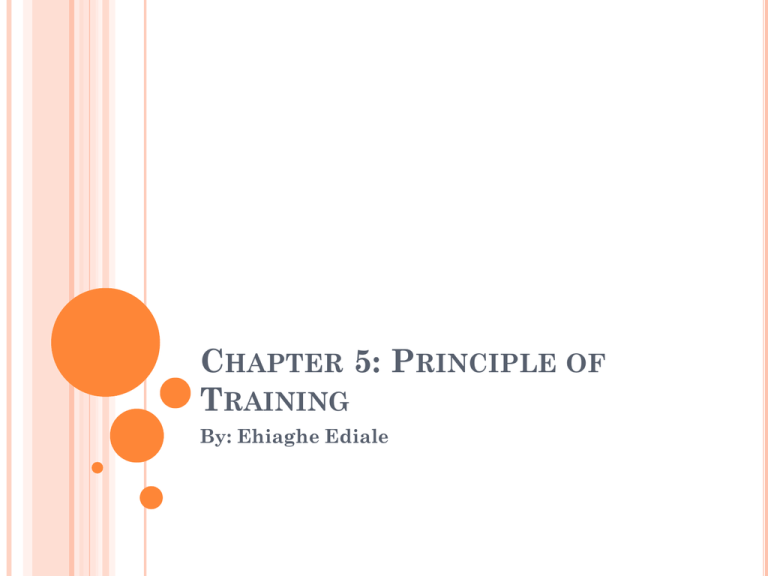Principle of Training By
advertisement

CHAPTER 5: PRINCIPLE OF TRAINING By: Ehiaghe Ediale EFFICIENT AND SAFE TRAINING You need to engage in regular physical activity in order to look and feel good. Also, when you engage in regular physical activity you enjoy a healthy lifestyle. You need to consider previous involvement in physical activity, present fitness level, present health, and past medical history. You need to follow a carefully planned and deliberate training program. The 3 basic training principles to be followed in developing a program are: overload, progression, and specificity. PRINCIPLE OF OVERLOAD The systems of the body are stronger and work better when you increase demands on them. Even though it’s important to overload your body, the stress shouldn’t be severe enough that your body will not be able to adjust. When that happens you would be unsuccessful, you will not enjoy the exercise session, and you can cause harm to your body. An example of the principle of overload being use is when Milo of Crotona lifted a small calf several times a week and as the calf grew heavier, Milo’s muscles grew stronger Milo of Crotona F.I.T F.I.T stands for: -Frequency- how often you exercise -Intensity- how hard you exercise -Time- how long you exercise FREQUENCY Frequency is the number of times you exercise. Exercise needs o be performed regularly. How often you exercise depends on you goals. Exercising 3 days a week is the minimum frequency and it will increase your level of fitness if the time is increased. INTENSITY Intensity- the degree to which one should exercise to improve fitness or how hard you work. The intensity of all exercises should be increased enough to demand more effort than usual. How hard you work depends on the fitness component (cardiovascular, muscular strength and endurance, or flexibility) and your present level of fitness. TO IMPROVE YOUR… Cardiovascular fitness- you must make you heart work harder than it normally does. The intensity of a cardiovascular workout is indicated by the number of times per minute your heart beats after the workout. Muscular strength and endurance- you must increase your intensity by lifting more weight. Flexibility- you have to stretch the muscle beyond its normal length. TIME Time- how long you exercise. In order for a training session to be effective, the session must be maintained for a certain length of time. As time is increased, intensity is decreased. For example, when a beginner can spread the training session over a longer period of time at an easier pace. PRINCIPLE OF PROGRESSION As you overload, your body adapts. So as your body becomes accustomed to the workload, you must progressively increase the amount of work for improvement to occur. STUDY GUIDE: QUESTIONS AND ANSWERS 1. What are the 3 basic training principles to be followed in developing a program/ Answer- Overload, Progression, and Specificity 2. What does F.I.T. stand for? Answer- Frequency, Intensity, and Time 3. Which vocabulary term refers to the number of times you exercise? Answer- Frequency 4. True/ False: It is good to be unusually tired during or after an exercise session. Answer- False 5. True/False: As time is increased, intensity is increased. Answer- False 6. When you improve specific components of physical fitness in specific body parts, you are using the principle of ___. Answer- Specificity 7. What must you do before starting a training program? Answer- Consider previous involvement in physical activity, present fitness level, present health, and past medical history. 8. True/False: Various systems of the body will become stronger and function better if increased demands are on them. Answer- True 9. True/False: How hard you exercise depends on the fitness component and your present level of fitness. Answer- True 10. True/False: you must progressively increase the amount of work for improvement to occur. Answer- True VOCABULARY TERMS Principle of Overload- exposing the muscles, joints, and cardiovascular and respiratory systems to more work and stress than is normally experienced F.I.T- the 3 ways to achieve overload in a physical fitness program– frequency, intensity, and time Frequency- the number of times one should exercise to improve a component of physical fitness Intensity- the degree to which one should exercise to improve fitness Time- how long one exercises to improve fitness Principle of Progression- a progressive increase in the level of exercise in order to sustain improvement in physical fitness Principle of Specificity- the performance of specific exercises in order to improve specific components of physical fitness in specific body parts THE END!!!! By: Ehiaghe Ediale



